Sage Oracle Dual Boiler: The friendliest high-end espresso machine in the world
How does Sage's new machine shape up?
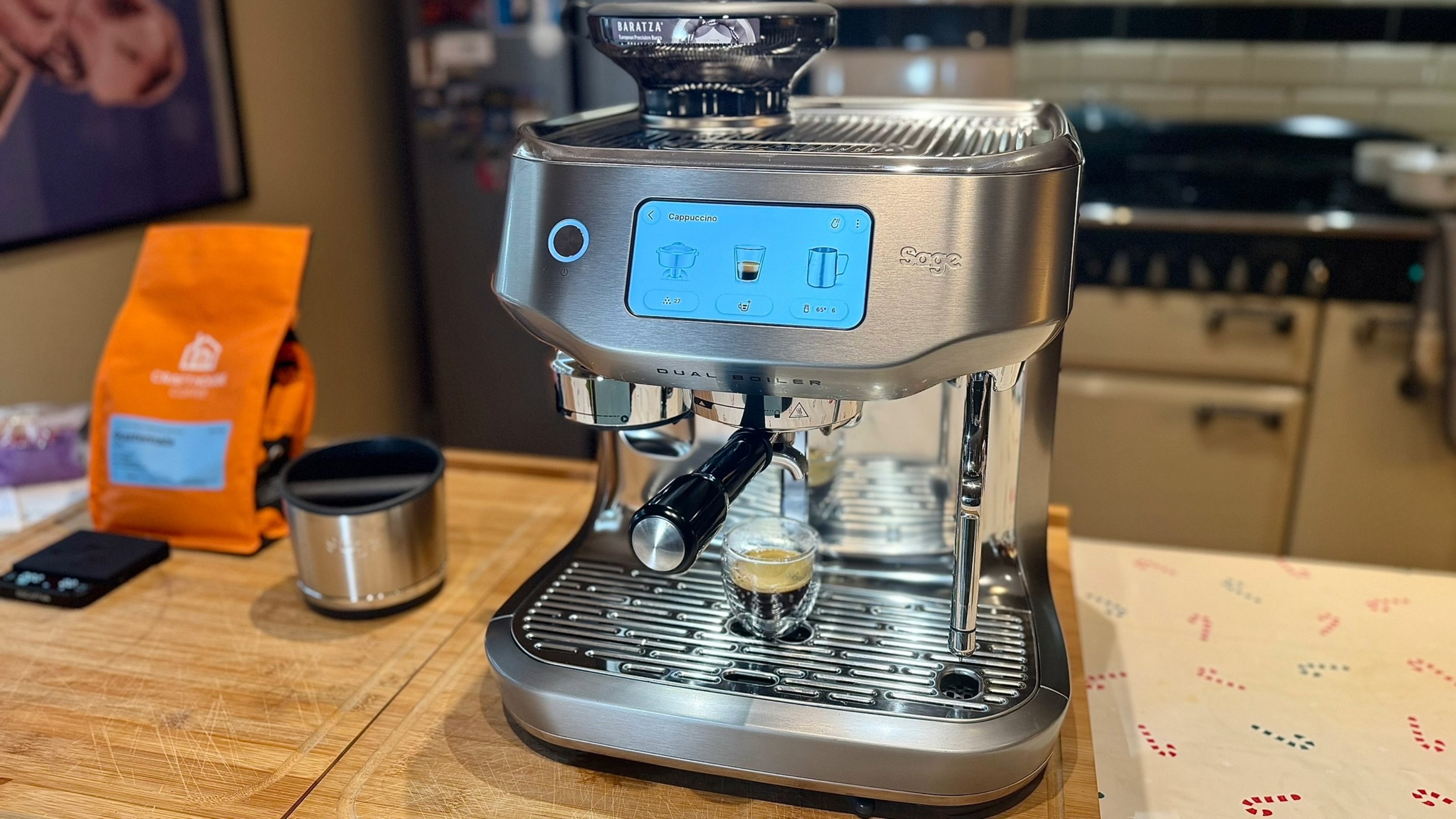
Sage supercharges its Oracle Jet with dual boilers – and the result is a stunning machine for beginners and baristas alike.
-
+
Makes stunning coffee
-
+
Superb milk texturing
-
+
Friendly touchscreen interface
-
-
Very expensive
-
-
Auto dial in needs refinement
-
-
Fully automatic machines are simpler
Why you can trust Ideal Home

The Oracle Dual Boiler from Sage is designed to be the ultimate assisted espresso machine. A bean to cup machine that, if you can afford it, is capable of recreating the shot-pulling talents of your local independent coffee shop in your very own kitchen. Here's how I got on with it.
In a nutshell
The concept of assisted espresso machines is nothing new, but the Oracle Dual Boiler takes it one step further than ever before. The dual boiler design is a first on a coffee machine of this kind, allowing you to simultaneously brew espresso and steam milk, and the huge colour touchscreen leads beginners by the hand or – with a swift upwards swipe – unlocks manual controls for budding baristas and experts alike.
The slight sticking point here is the price: at two and a half thousand pounds, the Oracle Dual Boiler is not an impulse buy. With that kind of budget at your disposal, you could take your pick from a vast selection of exotic coffee machines, spanning everything from fully automated bean-to-cup models to barista-focused manual espresso wunderkinds.
The magic of the Oracle Dual Boiler, however, is that it appeals to both camps at once – this is a machine that’ll brew world-beating coffee with anyone at the controls. The question is whether it’s the right machine for your home.
Product specs
- Dimensions: 38.7cm x 37.4cm x 45.5cm
- Weight: 17.24kg
- Capacity: 340g bean hopper, 2.3L water tank
- Pressure: 15 bars (9 bar brewing pressure)
- Included: 58mm stainless steel portafilter, stainless steel milk jug, knock box, water filter & holder, cleaning tablets, cleaning brush, hex keys, steam wand cleaning tool, cleaning disc, single & double shot filter baskets, water hardness strip, tamp removal magnet, descaling powder
- Grind settings: 45
- Options: Single or double shot, hot water, milk frother
- Drinks: 16, customisable (Espresso, Long Black, Cafe Crema, Latte, Cappuccino, Flat White, Cortado, Latte Macchiato, Mocha, Iced Latte, Espresso Martini, Espresso Shakerato, Latte Shakerato, Hot Chocolate, Babyccino, Tea)
- Adjustable features: shot volume, brew temperature, pre-infusion, grind size, milk texture & temperature
- Colours: Stainless Steel, Black Truffle
- Warranty: 2 year replace, repair or refund (at Sage’s discretion)
- RRP: 2,499.95
Unboxing and first impressions
If the Oracle Dual Boiler looks familiar, then that’s because it’s the turbocharged relation to Sage’s Oracle Jet – and it’s bigger and better in every way. Well, mostly, but we’ll get to that a little later in the review.
Be warned: this is a big coffee machine. Measuring almost 39cm wide, just over 37cm deep and almost 46cm tall, the Oracle Dual Boiler demands a sizable spot on your kitchen worktop. And when it comes to unboxing, we’d have a spare pair of hands at the ready – while the Oracle Jet was an already weighty 12.1kg, the Oracle Dual Boiler’s 17.4kg will give even the strongest arms a good test.
Thankfully, though, it’s easy to move once it’s on the kitchen counter. Simply slide the lever under the machine’s front lip to the right and it deploys wheels to allow you to move it around on the worktop without flexing your muscles. Given that the 2.3 litre water tank slots in and out of the rear of the machine, this comes in very handy – although thankfully you shouldn’t need to move it too often as you can fill the tank via a little flap at the front.
Sign up to our newsletter for style inspiration, real homes, project and garden advice and shopping know-how
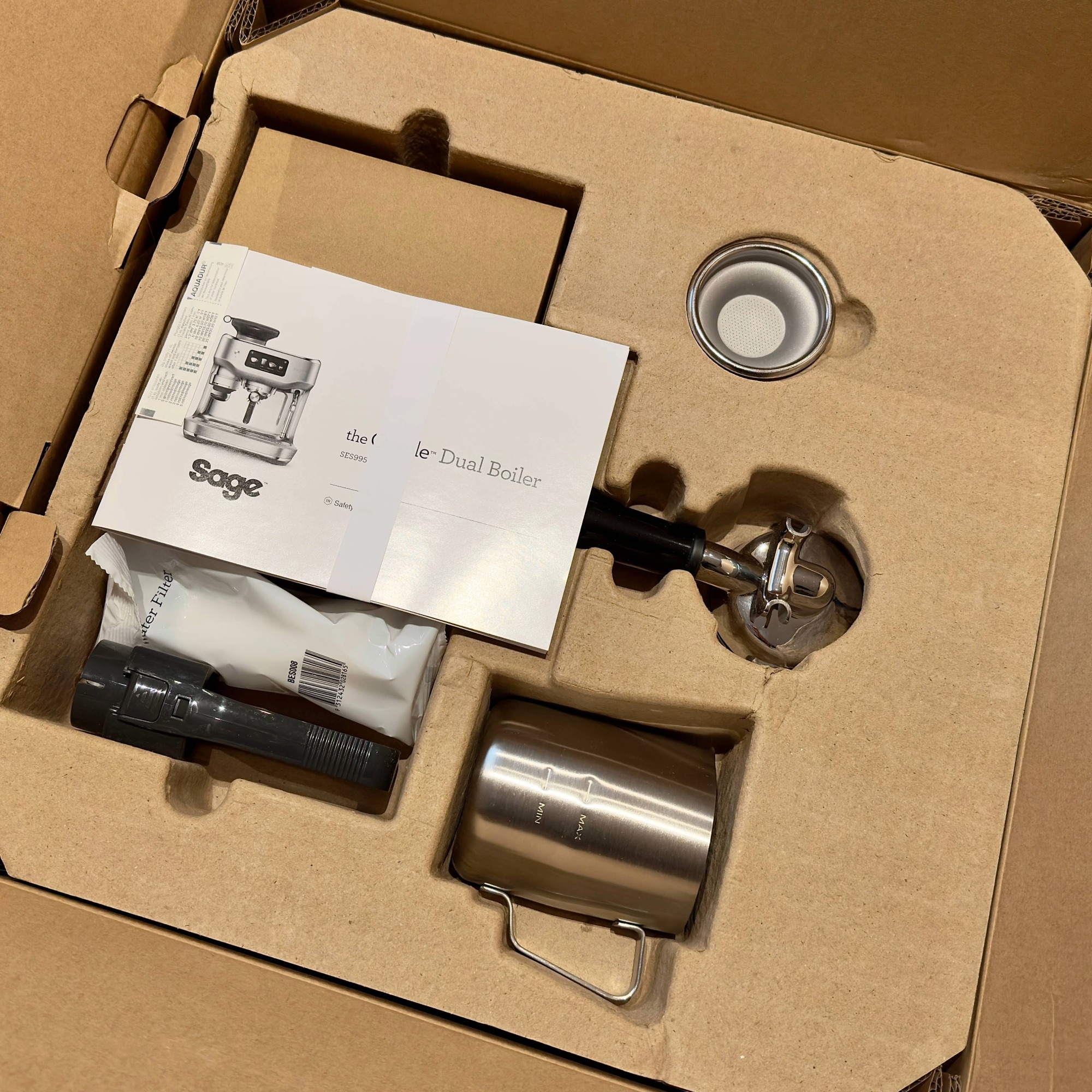
If one of your major concerns is complementing your kitchen decor, then you can take your pick from brushed stainless steel or matte black truffle. Whichever you choose, however, the Oracle Dual Boiler is a rather handsome, if brutish thing. The shiny metal finish on the splashback and drip tray glint attractively under the kitchen spotlights, and where the Oracle Jet used a little more plastic in its construction, the Dual Boiler is a tad more heavy metal – and it both looks and feels that bit more classy and upmarket as a result. Suffice to say, if you love the look of coffee shop espresso machines, you’ll probably be rather smitten with Sage’s take on the concept.
Once you’ve wrestled the machine onto your worktop and spent some time admiring the view, you’ll have time to sift through the various accessories in the box. Sage provides a stainless steel milk jug for milk frothing duties, a lovely weighty portafilter with both single and double shot baskets – both of which are finished in a fancier matte grey than the Oracle Jet’s stainless steel – and a variety of useful cleaning accessories and products, including brushes and tools for accessing the Dual Boiler’s various nooks and crannies.
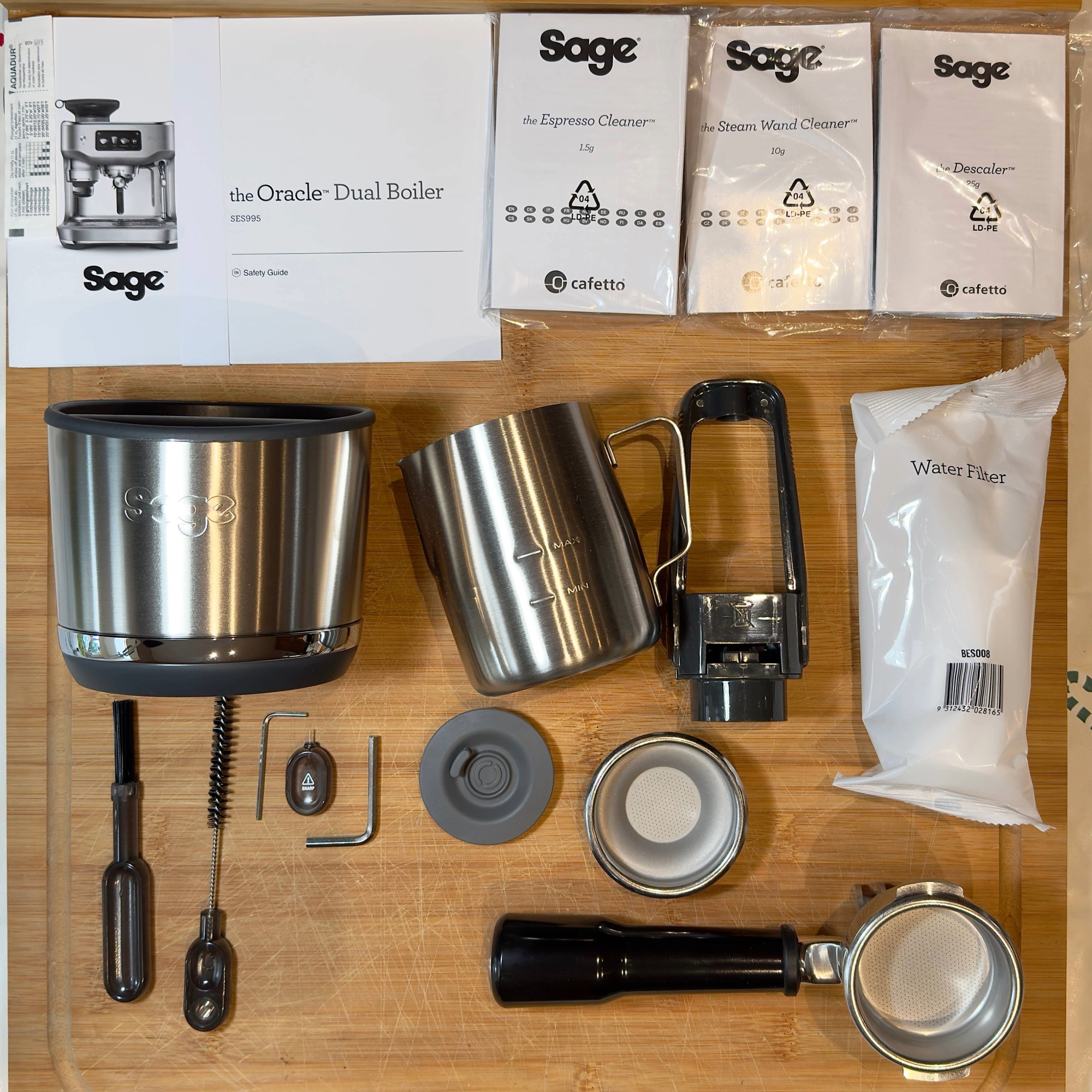
It’s nice to see a basic Sage knock box in the package, too, and this gives you somewhere to bash out the used pucks of coffee after each shot. Frankly, the only thing missing is a fancy barista apron for the full coffee shop cosplay experience.
What's it like to use?
Touchscreens on coffee machines are nothing new, but the Oracle Dual Boiler upgrades the 4.5in touchscreen on the Oracle Jet to a larger 5.7in panel. This looks stunning, and makes for a far less daunting sight for the beginner than the rows of dials and buttons found on cheaper coffee machines.
Straight out of the box, you’re faced with a slick setup process that gets you up and running and acquainted with the machine. The interface prompts you to connect to your Wi-Fi straight away – this looks for software updates and also allows you to connect to the iOS and Android Sage+ Coffee app. Our model found an update straight away and started downloading as we continued the setup process. And rather helpfully, the interface provides QR codes to save you searching for the app manually.
Throughout the setup process, clear text instructions blend with little animations and crisp icons, and it feels slick and smooth – where cheaper machines often go wrong is that the touchscreen feels jerky and unresponsive. Here, the quad-core processor and bright, vivid screen are anything but, responding promptly to taps and swipes.
The masterstroke here is that Sage uses full screen videos to show off the various functions – there’s no need to download the user manual at all. Each part of the process provides simple text summaries of each feature, and once you reach the annotated image of the machine itself, you can tap each labelled part to play a looping video which shows how each part works. It’s simple and effective; arguably much more so than poring over a text manual.
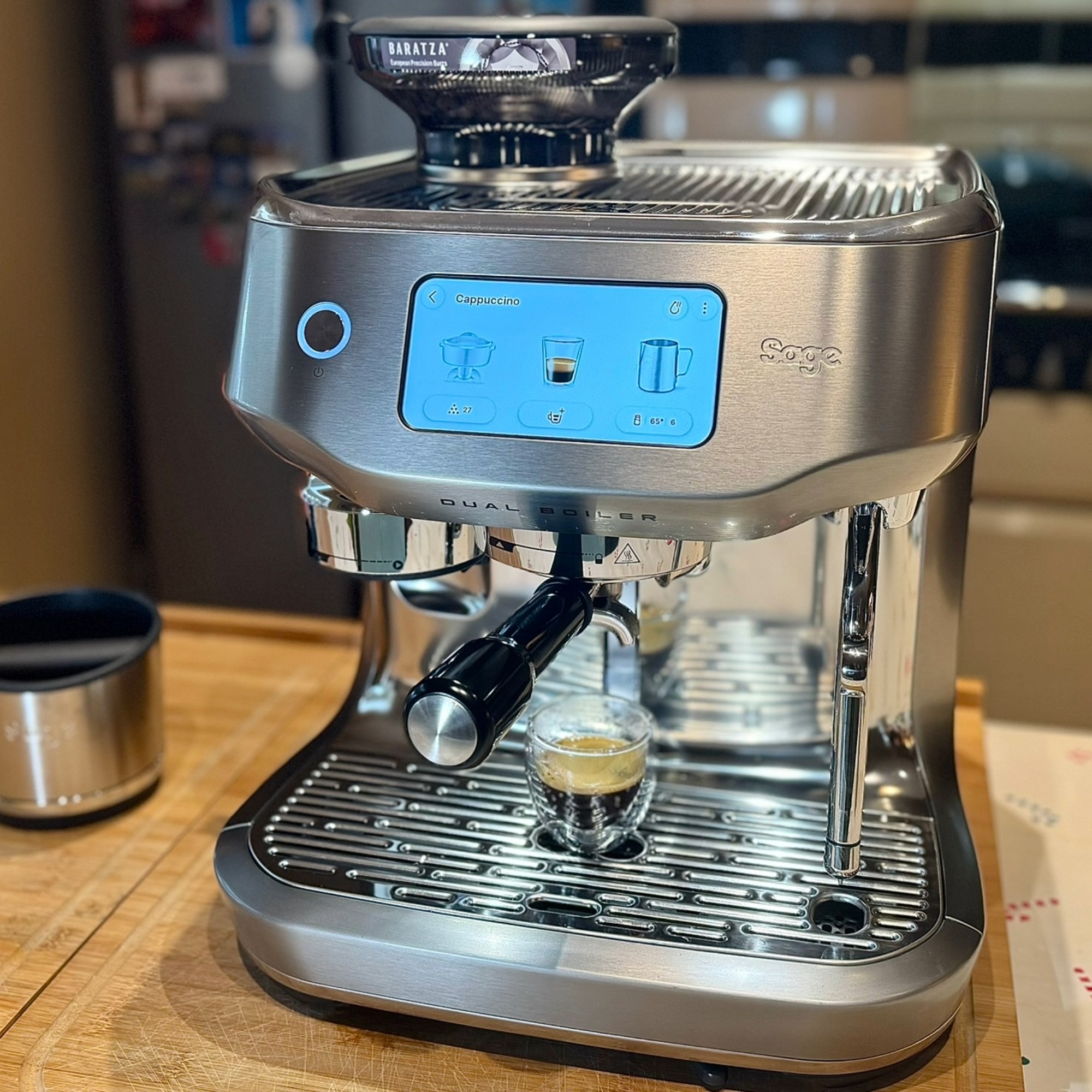
Once the setup is complete, and the 340g bean hopper filled with coffee beans, the machine leads you through the process of pouring your first espresso shot and steaming your first jug of milk. Again, each action is carefully guided with little highlights and text explainers, and you get to set your default preferred Auto MilQ steaming mode to suit dairy, oat, almond or soy milks.
For anyone who’s battled with a fully manual machine, the simplicity of the workflow is impressive. The portafilter slots into the grinder and a quick flick to the right sets the grinder whirring. The burrs spin up surprisingly quietly, and the machine automatically grinds the correct amount of coffee and tamps it down for you with the integrated tamping fan. All that’s required is to slot the portafilter into place, and tap the espresso icon. Around 30 seconds later, you have a delicious-looking espresso in your cup. And the dual boiler design means that, while the espresso is pouring, you can tap the milk icon and allow the Auto MilQ function to simultaneously steam your preferred milk to perfection. It’s all incredibly slick.
Tea and americano drinkers aren’t left out either. The hot water dispenser now pours more smoothly thanks to it using a jug-like metal spout rather than the plastic nozzle on the Oracle Jet, which is a nice little touch.
In fact, the only slight downgrade here is that the new dual boilers take around 5 minutes to warm up. This means that the Oracle Jet with its near-instantaneous warm up is still the faster machine if you want a rapid coffee in the mornings. And this is partly (or largely) why Sage has added the app functionality here: you can turn on the Oracle Dual Boiler from your smartphone. If you wake up, open the app and tap the on button, the boilers will be up to temperature by the time you get to the kitchen.
Coffee quality
One of the big new features for the Oracle Dual Boiler is its Auto Dial In feature. This monitors the brewing process and aims to ensure that you’re getting an optimal extraction for every shot of espresso. This, in my testing, was the first mis-step by the machine. The first shots used the default grind size, poured in around 35 seconds, and the interface immediately responded with a screen suggesting that the result in the cup was a Balanced brew, advising that no changes to the grind size were necessary.
In reality, though, the first shots were a little too intense and unbalanced – this is because the machine was taking 22g of ground coffee and producing around 28 grams of espresso in the cup after brewing for around 35 seconds. That’s somewhere in the region of a ristretto shot, in essence – but in my opinion that’s a little too strong as a default setting. After a few more espressos, the machine automatically adjusted the grind size one step coarser. After this, the machine poured the same amount of espresso in just under 30 seconds. This was a little better, but still too intense. With milk, the punchy ristretto shot worked quite well – with the intensity of the shot cutting through more – but it wasn’t so enjoyable on its own.
At this point, I stepped in and manually increased the shot size setting by one notch. That done, the machine immediately poured a vastly more balanced shot – with around 41 grams of espresso in the cup, the balance of sour, bitter and sweet was far more pleasant. Suddenly, the blackberry and cherry tasting notes on the bag of Guatemalan Paya beans made sense, and it was far more pleasant to sip without milk. And with milk, I preferred it, too, as it was just that bit more delicate and balanced.
While it’s a shame that the Oracle Dual Boiler didn’t nail my preferences straight away, it took only two taps of the touchscreen to improve the shot – and that’s easy for even beginners to do. Adjust one setting to your tastes and once you’ve got it just so, you can save it as the default drink and get consistently great results time after time with very little effort. That’s not to be sniffed at.
I have a feeling that software updates may improve the Auto Dial In function as time goes on, so I’ll keep an eye on it in the coming weeks and monitor how the default shot behaviour changes over time. If things change, I’ll update this review with my findings.
If, however, you count yourself as more of an expert, the Dual Boiler has an ace up its sleeve: Manual mode. Swipe up from the main screen, and you’re faced with a cool little fascia where you can see the brewing pressure on a tachometer-style dial and quickly adjust all the key brewing settings. You can adjust the shot volume, tweak temperature in 1 degree increments, tinker with the pre-infusion settings and take control of the grind size and timings, too. Find your perfect settings, and you can save them to use again later. For coffee aficionados who were tempted by the Oracle Jet, but craved more control, the Manual mode is a bit of a game changer in my opinion.
Sage’s Auto MilQ feature works brilliantly. The cool touch steam wand is a welcome sight, too – as the name suggests, it doesn’t get searing hot, which is a welcome safety feature. It’s also a little daintier than the Oracle Jet’s wand, which makes for easier manual steaming, if you insist on doing so.
Indeed, while you can steam the milk manually if you prefer, there’s very little point for most people – the automatic results are about as good as it gets for most mere mortals. I tested it with dairy and oat milks, and was consistently impressed. Admittedly, the Oatly Barista I used didn’t give the same silky, paint-like texture as full-fat dairy milk, but it wasn’t a million miles off. And the results with dairy milk were great – so great, in fact, that I no longer have any excuse for my terrible latte art skills.
Cleaning
One really important thing with coffee machines – and especially so when you’re spending this much money – is performing maintenance and cleaning for the parts you can’t see. It’s great to keep the machine gleaming, but you also need to invest in the correct cleaning products and get into a habit of performing the correct maintenance to keep the insides of the machine free from coffee residue or limescale.
Thankfully, Sage supplies some useful cleaning products and gadgets in the box. You get one sachet of descaling powder, a couple of cleaning tablets and a blanking plate for backflushing the brewing group, and a couple of sachets of powder for soaking away milk residue on the steam wand.
You also get a tool for removing the automatic tamper, and this includes a brush for wiping away trapped coffee grounds. A second softer brush is also included for wiping away coffee grounds from nooks and crannies.
Like all of Sage’s coffee machines, the Oracle Dual Boiler comes with an inline water filter which slots into the water tank at the rear. This lasts for around 3 months under normal usage, and the machine will prompt you to replace it on a set schedule – the water hardness strip in the box lets you test and input your water hardness into the touchscreen, and adjusts the filter replacement reminders to suit. It’s imperative to use the filter to slow limescale buildup, as well as to subtly improve flavour, so it’s not something to skimp on.
How does it compare to similar coffee machines?
Assisted espresso machines are becoming increasingly popular, but few – if any – are as expensive as the Oracle Dual Boiler. And frankly none are as capable. The obvious downside of all the upgrades, however, is that the price soars upwards. With £2,499 in your pocket, the world is your oyster when it comes to alternative machines.
And yes, there are far more affordable options on the market. The key budget rival is the Ninja Cafe Luxe ES601 (£499). At the price, it’s no surprise that it has a far clunkier look and feel, but it produces a really tasty range of assisted espresso drinks – and beyond – at a fraction of the price. The results aren’t anywhere near as refined as the Sage, but if you just want good quality results from supermarket coffee – and you like the idea of dabbling with fancier coffee from time to time – it’ll make a better-tasting cup than fully automatic machines at twice the price.
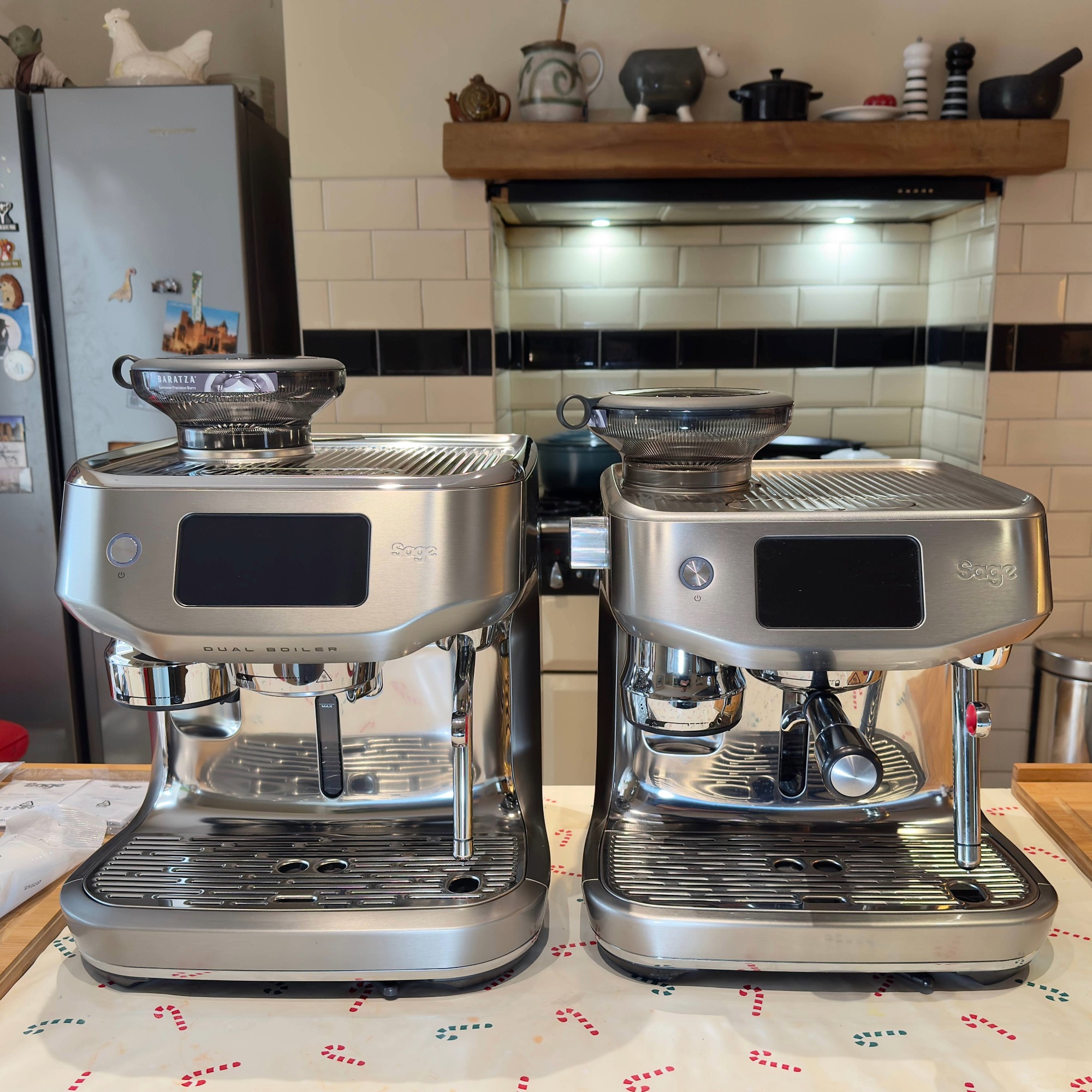
If, however, you’re dead set on having a Sage, and love the idea of a more stylish design and a friendlier touchscreen interface, you should consider the Barista Touch Impress with Cold Extraction (£1,200) – at the time of writing, it was retailing for £1,000 direct from Sage’s website. This is a machine that you’ll regularly see discounted during the various seasonal sales periods, and while you could argue that it isn’t twice as good as the Ninja, it’s markedly better at teasing out all the gorgeously subtle flavours of top-notch coffee – and it’s far easier to use. For some buyers, this will be the sweet spot between price and performance. And again, it’ll make far better coffee than any fully automatic machine.
One final high-end option I’d suggest is the Oracle Jet (£1,700). It lacks the Dual Boiler’s fully manual mode, but if you don’t want to faff with settings, it’s capable of making equally amazing coffee – and it’s actually better in some ways. As the Oracle Jet uses a thermojet rather than a traditional boiler, it’s ready to brew in seconds – not minutes. The thermojet design means that you do have to brew coffee and steam milk one after another, but if you’re only making one or two drinks, the faster heat up time means that it’s actually quicker than the Dual Boiler. And the increased temperature flexibility means that you also get proper cold brew coffee brewing – something which the Dual Boiler can’t do.
Should you buy the Sage Oracle Dual Boiler?
The Sage Oracle Dual Boiler is a big investment, but for some households it may be the perfect do-it-all machine – there’s no other assisted espresso machine that I’ve reviewed which does such a good job of appealing to both beginners and skilled baristas.
It fuses high-end espresso engineering with arguably the slickest, most user-friendly interface money can buy – and the coffee it produces is just downright superb. That very particular set of skills means that it’s not for everyone, but if money is no object, this may be the machine you’ve been waiting for.

Sasha Muller is a journalist, editor and reviewer with over two decades of experience. Sasha has written for a wide range of tech and home publications, including The Sunday Times, Expert Reviews, PC Pro, IT Pro and Top Ten Reviews.
He’s reviewed and written about everything from the latest home appliances and kitchen gadgets to TVs, laptops, Hi-Fi and outdoors gear. Now living minutes from Cannock Chase, Sasha spends much of his spare time walking with his family, mountain biking or inadvertently testing out the waterproofing of his all-weather gear in the great British outdoors.
You must confirm your public display name before commenting
Please logout and then login again, you will then be prompted to enter your display name.